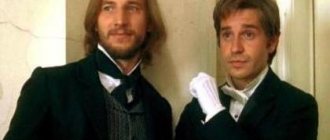4.6
Average rating: 4.6
Total ratings received: 131.
4.6
Average rating: 4.6
Total ratings received: 131.
The works of Chekhov, one of the most famous Russian writers, are included in the literature curriculum in all secondary school classes. His stories, novellas, and plays have been translated into more than a hundred languages and have been staged in theaters all over the world for more than a hundred years. Analysis of the story by A.P. Chekhov's “Anna on the Neck” includes an overview of the themes, issues, structure, features of the genre and artistic means of expression that the author used in this work.
The material was prepared jointly with a teacher of the highest category, Ilyina Galina Sergeevna.
Experience as a teacher of Russian language and literature - 36 years.
Brief Analysis
Before reading this analysis, we recommend that you familiarize yourself with the work Anna on the Neck itself.
Year of writing : 1895.
History of creation - Long before writing the story, Chekhov sketched out the plot in his working notes. In 1895, the story was published in Russkie Vedomosti, but later, for collected works, it was slightly revised. The finished work differs from the author’s original idea in its clear composition and depth of elaboration of the character of the main character.
The topic is the influence of wealth, position in society on the spiritual world, the moral side of the individual.
Composition - The work has two chapters: the storylines of the main character and her husband are given separately.
Genre : short story, lyrical-dramatic story.
Direction – critical realism.
History, genre, theme and issues
Anton Pavlovich Chekhov's story “Anna on the Neck” was written and published in 1895, but the sketches were made by the writer earlier.
In these drafts, the author came up with a story arc in which a young woman, for the sake of profit (saving her family from poverty), goes down the aisle with an unpleasant rich old man. But the husband is in no hurry to part with money for the sake of his new wife. In the published version, Chekhov changes the details, but the idea remains the same. In October, the story was published in Russkie Vedomosti, and later the writer included it in his collected works. The genre of the story is a lyrical-dramatic short story with Chekhov’s characteristic humor. The topic is the social status of society, relationships between people from different strata, the influence of money on the spiritual side of the individual. The clash of morality (spiritual) and material is the problem of the work.
History of creation
The writer's notes have been preserved, in which he developed the plot line of the future story. It said that a young schoolgirl marries a fat, ugly old man in order to save herself and her brothers from poverty.
The husband turns out to be stingy, reproaches her, and does not give her money. Wanting to take a more honorable place in society, he takes his wife to a ball, where she becomes the center of attention and has a dizzying success. Realizing her winning position, Anna calls her husband a fool, cheats, and spends his money.
The final version of the story differs in some details, but in general the plot corresponds to the author's original idea. In October 1895, Anton Pavlovich sent the text of the story to the editors of Russkiye Vedomosti, and on October 22 the work was published. Having deepened the image of the main character, giving satirical features to the images of Modest Alekseevich and “his excellency,” the author included the story “Anna on the Neck” in the 9th volume of collected works of 1899–1901.
Check out what else we have:
for the most rational -
Summary of “Anna on the Neck”
for the coolest -
Read “Anna on the Neck” in full
Subject
In the story, Chekhov touches on important themes concerning human existence: wealth and poverty, morality and spiritual decline, the meaning of life, philistinism. The main problem of the work is social inequality and its impact on life (how a person’s worldview and personality change in a society built on the power of money).
The lives of Anna and her husband are shown in parallel; they do not intersect. These are strangers to each other, who have achieved what they dreamed of, but have lost something very important. Anna gained wealth, position in society and from this a feeling of happiness, but her soul hardened, she forgot about her brothers and father, who were in desperate need of help. Modest Alekseich received the desired ranks and awards, but lost the respect of his wife and became her “servant.”
The meaning of the title of the work is that along with the desired reward (the Order of St. Anne, which was worn around his neck), the main character received another Anna - a harlot wife, ungrateful, wayward, who also ended up “on his neck.”
Analysis of the story “Anna on the Neck”
Brief Analysis
- Year of writing: 1895
- History of creation - long before writing the story, Chekhov sketched out the plot in his working notes. The finished product is practically no different from the author’s original idea.
- The topic is the influence of wealth, position in society on the spiritual world, the moral side of the individual.
- The composition is a two-plane composition, consisting of the line of the main character and her husband. The work is divided into two chapters
- Genre: short story, lyrical-dramatic story.
- Direction – critical realism.
Detailed analysis
History of creation
The writer's notes have been preserved, in which he developed the plot line of the future story. It suggested that a young schoolgirl marries a fat, ugly old man in order to save herself and her five brothers from poverty.
The husband turns out to be stingy, reproaches her, and does not give her money. Wanting to take a more honorable place in society, he takes his wife to a ball, where she becomes the center of attention and has a dizzying success. Realizing her winning position, Anna calls her husband a fool, cheats, and spends his money.
The final version of the story differs in some details, but in general the plot corresponds to the author's original idea. In October 1895, Anton Pavlovich sent the text of the story to the editors of Russian Vedomosti, and on October 22 the work was published.
Having slightly modified the image of the main character, changing minor details, the author included the story “Anna on the Neck” in the collected works of 1899–1901.
Subject
In the story, Chekhov touches on the most pressing topics concerning human existence: wealth and poverty, morality and spiritual decline, the meaning of life, philistinism. The main problem of the work: social inequality and its impact on a person’s life, worldview and personality.
The lives of Anna and her husband are shown in parallel; they do not intersect. These are strangers who have achieved what they dreamed of, but have lost something very important. Anna gained a sense of happiness, wealth and position in society, but her soul became hardened, she forgot about her brothers and father, who were in desperate need of help. Modest Alekseich received the desired ranks and awards, but lost the respect of his wife and became her “servant.”
The meaning of the title of the work is that along with the desired reward (which was called Anna and was worn only by hanging it around his neck), the main character received another Anna - a libertine wife, ungrateful, wayward, who also ended up “on his neck.”
Composition
The composition is two-dimensional: the story is divided into two chapters. The first tells about Anna's life before her first appearance. The second is about a radically changed situation that turned the entire way of the family upside down after the first ball, the resounding success of Modest Alekseich’s young wife. The entire narrative is built on a clear antithesis, on “before” and “after”.
The ring design of the composition is given by a leitmotif from the poor past life of the main character: “No need, daddy” - sounds from the lips of the three children of a widowed old teacher, at the end of the story - these words are repeated by Anna’s two brothers. She becomes part of the new world, forgets about poverty and the need of those closest to her.
Genre
In the story “Anna on the Neck,” the analysis involves considering the peculiarities of the genre of small prose form, which is characteristic specifically of A.P. Chekhov. The author loves laconicism in everything, does not always use the denouement, he likes to leave the reader wondering how the work will end (as a rule, the outcome is obvious).
Composition
The composition is two-dimensional: the story is divided into two chapters. The first tells about Anna's life before her publication. The second is about a radically changed situation that turned the entire way of the family upside down after the first ball, the resounding success of Modest Alekseich’s young wife. The entire narrative is built on a clear antithesis, on “before” and “after”.
The ring design of the composition is given by the leitmotif from the poor past life of the main character: “No need, daddy” - sounds from the lips of the children of the widowed old teacher; at the end of the story these words are repeated by Anna’s two brothers. She becomes part of the new world, forgets about poverty and the need of those closest to her.
Genre
Analysis of the story “Anna on the Neck” involves consideration of the peculiarities of the genre of small prose form, characteristic of the prose of A.P. Chekhov. The author loves laconicism in everything, does not always add a denouement, it is typical for him to leave the reader wondering how the work will end (as a rule, the outcome is obvious).
Satirical images behind which there is a tragic meaning - this feature of Chekhov as a prose writer and playwright manifested itself in this story. Thus, “Anna on the Neck” is a lyrical-dramatic story, or short story, which is confirmed by its brevity, abrupt change of events, and unexpected transformation of the main character.
The problem of personality degradation in A. P. Chekhov’s stories “Anna on the Neck” and “Ionych”
Anton Pavlovich Chekhov entered Russian literature at the very beginning of the 80s of the 19th century. This era was poor in major historical events and even began to be called “stagnant times.” Therefore, the writer’s work reflected both disappointment in the salvation and renewal of Russia, and a rethinking of the system of spiritual values. All of Chekhov's artistic activity is a call for spiritual liberation and emancipation of man. The voice of inner freedom, and not an attempt to find the truth, sounds in almost every one of his works. The writer writes simply and clearly, not at all like Dostoevsky and Tolstoy. This original feature was reflected not only in the language of stories and tales, but also in the plot of his works. In Chekhov, as a rule, they unfold calmly, smoothly and clearly. In his prose there is no external conflict between the heroes, an energetic and fierce struggle, or a fatal coincidence of circumstances. Chekhov's mastery is the art of large generalizations in a small form. He shows life not in full, like Goncharov or Turgenev, but in miniature, taking into account all the strokes and details. Humor, especially in depicting people's characters, is one of the leading features of Chekhov's style. He ridicules stupidity, lack of culture, vulgarity, philistinism, careerism, sympathizes with “little people,” etc. From the end of the 80s, the second period of A.P. Chekhov’s work began, marked by a significant deepening of the problematics of his works (themes such as the “case” life of the intelligentsia, problems of social significance, heroes who began to see the light and degenerated appeared). In these “serious episodes,” the humor that was present in the earlier works was preserved, but acquired different shades, connecting with new themes. Here the writer critically depicts public passivity, vulgarity, indifference, lack of social demands among the intelligentsia, etc. The heroes of most of these works belong to the middle social class. These are doctors, teachers, students, officials and less - landowners. But Chekhov is now more interested in the human qualities of the characters than in their social affiliation. The author does not focus much attention on the hero’s conflict with society, presenting him as part of this environment. Chekhov explored the inner world of man, the influence of everyday life and circumstances on the consciousness and psychology of the average person. It was during this period of creativity that such famous stories as “Anna on the Neck”, “Little Trilogy” (“Man in a Case”, “Gooseberry”, “About Love”), “Literature Teacher”, “A Boring Story”, “House” appeared. with a mezzanine”, “Lady with a Dog”, “Ward No. 6”, “Ionych” and many, many others. Anya is the main character of the story “Anna on the Neck.” This is not at all an inactive person who does not care about anything. On the contrary, she actively participates in the life of society, enjoying the pleasures and entertainments of the world. At the beginning of the story, this young girl marries a rich old man, Modest Alekseich, to help her needy and hungry brothers. This episode even evokes sympathy, because before us is a typical “unequal” marriage. Anya was exhausted, forced to “look after her drunken father, darn her brothers’ stockings and go to the market.” For the sake of her family, she is ready to do anything, even become the wife of the rude, vulgar and hated Modest Alekseich. But will her life change? With a stingy husband it is even more difficult for her than at home, where it was fun and she felt free. And it turned out to be impossible to help the family. Now Anya was rich: her husband gave her “rings, bracelets, brooches,” while recently she was ashamed of her “cheap hat and holes in her shoes, covered in ink.” And now the heroine appears for the first time in high society. This episode is the culminating, turning point in the structure of the story, in which two main parts can be distinguished: the marriage of the main character, life and secular society. At the ball, Anya transforms from a “downtrodden”, timid girl into a “proud and self-confident” lady: “And for the first time in her life she felt rich and free. Even the presence of her husband did not embarrass her...” Having liked her husband's boss, Anya acquired power over Modest Alekseich. She, who was so afraid even of the sound of his steps, now clearly says in his face: “Go away, you idiot!” Now she lives as she wants, in luxury, self-confidence and self-satisfaction appear in her. Yes, indeed, Anya laughs cheerfully, flirting with influential people, she got the better of her husband, but this victory came at a very high price - at the cost of losing her own soul. This is clearly visible at the end of the story, when the heroine, while riding horses, does not notice her own father and brothers. The author completes the story with this scene. The process of spiritual degradation, according to the author, cannot be prevented. Anya was swallowed up by secular society, she lost the ability to sincerely feel and love. “Anna on the Neck” is the story of the impoverishment of the human soul, the loss of spiritual qualities, which are the main wealth of man. What is important for Chekhov is the ability to stop, look back, interrupt a series of repeating events, and open oneself to the perception of the spiritual world. It is this ability that is the key to victory over vulgarity, but the heroine of the story did not understand this. Let's consider the evolution of the character of the main character of the story “Ionych”, Dmitry Ionych Startsev. We can distinguish four stages in the life path of Doctor Startsev, in revealing the content of which Chekhov succinctly demonstrates the gradual impoverishment of the hero’s spirit, the weakening of his will, the strength of resistance, the loss of activity, and a living human reaction. At the first stage, Dmitry Startsev is a young man who has just been appointed a zemstvo doctor and settled in Dyalizh, not far from the provincial town of S. He is a young man with ideals and a desire for something high. He is full of strength, energy (“... Having walked nine miles and then went to bed, he did not feel the slightest fatigue”), he is so passionate about work that even on holidays he does not have free time. He is interested in literature and art, he feels like a stranger among ordinary people. Doctor Startsev meets the Turkin family, “the most educated and talented” in the city. The way of their home suggests that even the life of the Turkin family is surprisingly monotonous (the same jokes, entertainment, activities), ordinary, typical. And this is the best family in the city. And if the best people are like this, then what are the rest? Here Chekhov accurately notices the phenomenon of philistinism using the example of one family. This is the life the young doctor Startsev plunges into. He tries to fight her, is in love with Kotik, is full of hopes, etc. But at the second stage, Dmitry Ionych, having made an unsuccessful proposal to Kotik and received a refusal, no longer tries to resist the circumstances, he understands what a quagmire he is plunging into, but does not try anything undertake; Thus, Startsev hides in a “case”, fenced off from the whole world. He stops walking, suffers from shortness of breath, and likes to snack. Rides a pair of horses. He does not yet have close friends; ordinary people irritate him with their views on life less and less. The doctor’s main entertainment, which “he got involved in unnoticed, little by little,” was in the evenings taking white and green pieces of paper obtained from practice from his pockets. Already at the third stage, Startsev moves away from the zemstvo hospital, his attention is absorbed by a large private practice. Now he is getting even fatter, suffering from shortness of breath even more: “He no longer rode out on a pair of horses, but on a troika with bells.” Finally, at the fourth stage, Dmitry Startsev’s life is completely devastated and impoverished, he is infected with hoarding, he has an estate and two houses in the city, but he does not stop there, he recalls with pleasure the pieces of paper that he took out of his pockets in the evenings and sorted through them with reverence . Startsev worked all his life, but activity devoid of purpose turns out to be disastrous. And we see how, as a result of the loss of meaning and purpose in life, personality is destroyed. Gradually, Doctor Startsev turned into Ionych. The journey of life is over... We can conclude that Startsev, understanding everything perfectly, did not try to change anything. Chekhov himself blames him for this. Showing the evolution of Startsev from a young doctor, a lively and emotional person, to an obese, plump Ionych, who, in his troika with bells, seems not like a man, but a “pagan god,” A.P. Chekhov exposes, thus, the environment that influenced the main character the story has a pernicious effect, and himself. Using the example of Doctor Startsev, the story shows the interaction of a weak and passive character with a spiritually impoverished society and the influence of this society on a person who is incapable of resistance and upholding positive principles in himself. The ability to show the small in the big, the combination of humor with sarcasm are the main techniques through which Chekhov’s stories reveal vulgarity and philistinism, which can ruin even smart, educated people... In his works, Anton Pavlovich Chekhov appeals to readers not to succumb to the influence of the philistine environment, to resist circumstances, not to betray eternal ideals and love, to protect the human in oneself.




